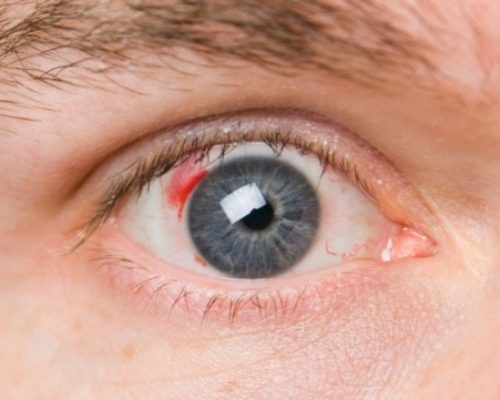How To Get Rid Of Blood Clot In Eye

Blood clot in the eye and how to get rid of it
Written by
Published on May 19, 2017
The eyes are delicate organs and can be prone to injury and damage. Blood clots in the eye often appear as red spots and can occur spontaneously. They are generally considered harmless and disappear on their own. These clots form underneath the outermost layer of the eye, called the conjunctiva, and are the result of accidental injury.
The medical term for this condition is subconjunctival hemorrhage. It may be described as a patch or spot of redness in the whites of the eye and could shift position. This white part of the eye consists of many blood vessels and nerves. Due to their delicate nature, these blood vessels get ruptured in response to a direct hit or injury. Consequentially, a clot forms at damaged sites to prevent excessive blood loss. Over time, these red spots will change in color as your body clears the clot, restoring your eyes to normal.
If the clot is the result of an injury, it may cause painful eye symptoms and possibly affect your vision.
How do you get a blood clot in your eye?
The most common reason for a blood clot in the eye to appear is an injury. However, there are other potential causes that make these appear. These can include:
- Excessive eye strain
- High blood pressure
- Constipation
- Stress
- Excessive coughing or sneezing
- Diabetes
- Medications such as blood thinners.
Symptoms of a blood clot in the eye
The following are potential signs and symptoms:
- Blurred vision: One of the more common symptoms that occur if the damage is severe. The retina is unable to filter light effectively, resulting in blurred vision.
- Pain in the eye: It's often described as sharp, aching, or throbbing. Pain accompanies blurry vision and a red eye, and it could be worse by looking at bright lights.
- Eye redness: This symptom occurs due to the blood vessels of the eye dilatating as they are engorged with blood. The dilation may occur due to suddenly elevated pressure in the blood vessels.
- Double vision: Also known as diplopia, it means you see two images of the same object. There are two forms of this conditions: monocular diplopia—double vision in a single eye—and binocular diplopia—double vision both eyes.
- Watery eyes: Damage to the blood vessels may send light-stimulated nervous communication to the brain, leading to watery eyes.
- Sudden and complete loss of vision: If a blood clot in the eye is really big, it may cause complete loss of vision. It could be temporary or permanent, and may affect one or both eyes.
- Eye bulging: This is a damaging effect that can be initiated by a blood clot in the eye. Eye bulging may also present with pain, redness, and blurry vision.
- Swelling of the eyelid: May present alongside itching and pain, but is painless in most cases. This often occurs around the orbit of the eye.
- Presence of eye floaters in the field of vision: Described as specs or tiny strings that appear to move through a person's field of view. Floaters are objects in the liquid found inside the eye itself and are common in mild cases eye blood clots.
Diagnosing blood clot in eye
Most cases of a blood clot in the eye are mild, resolving on their own. But there may be cases that require the expertise of a medical professional, especially if pain persists for a long time. The following are tests that can assess the extent of the damage:
- Computer tomography scan (CT)
- Magnetic resonance imaging (MRI)
- Electrocardiogram (ECG)
How to get rid of blood clot in eye
Typically, minor cases of subconjunctival hemorrhage do not require any treatment. The extent of the injury often dictates the length of time needed for complete resolution. This may be as short as three days or as long as a couple of weeks.
Blood clots in the eye are made up of the same material that causes blood clots elsewhere in the body and are absorbed in the same manner. It is important to speak your doctor if there is a concern of vision loss.
Most cases can be remedied by resting and not rubbing the eyes, as this increases the risk of bleeding. The following are some home remedies that help alleviate discomfort and speed up the healing process:
- Hot compress over the eyes
- Eye cubes wrapped in cloth over the eyes
- Cucumber slices can help create a soothing effect
- A few drop of rose waters helps cool and clean the eyes
- Consuming four cloves of garlic daily can be beneficial, as garlic is known for containing anticoagulant-like properties,
- Avoid sources of eye strain, such as the prolonged durations in front of a computer screen or TV
- Performing eye exercise to prevent eye strain
- Use a towel soaked in warm water and apply it to the eyes to relieve irritation
It is important to seek immediate medical attention during instances of severe eye injury or when symptoms do not go away.
Author Bio
 Emily Lunardo studied medical sociology at York University with a strong focus on the social determinants of health and mental illness. She is a registered Zumba instructor, as well as a Canfit Pro trainer, who teaches fitness classes on a weekly basis. Emily practices healthy habits in her own life as well as helps others with their own personal health goals. Emily joined Bel Marra Health as a health writer in 2013.
Emily Lunardo studied medical sociology at York University with a strong focus on the social determinants of health and mental illness. She is a registered Zumba instructor, as well as a Canfit Pro trainer, who teaches fitness classes on a weekly basis. Emily practices healthy habits in her own life as well as helps others with their own personal health goals. Emily joined Bel Marra Health as a health writer in 2013.
How To Get Rid Of Blood Clot In Eye
Source: https://www.belmarrahealth.com/blood-clot-eye-get-rid/
Posted by: culpepperconifice88.blogspot.com

0 Response to "How To Get Rid Of Blood Clot In Eye"
Post a Comment